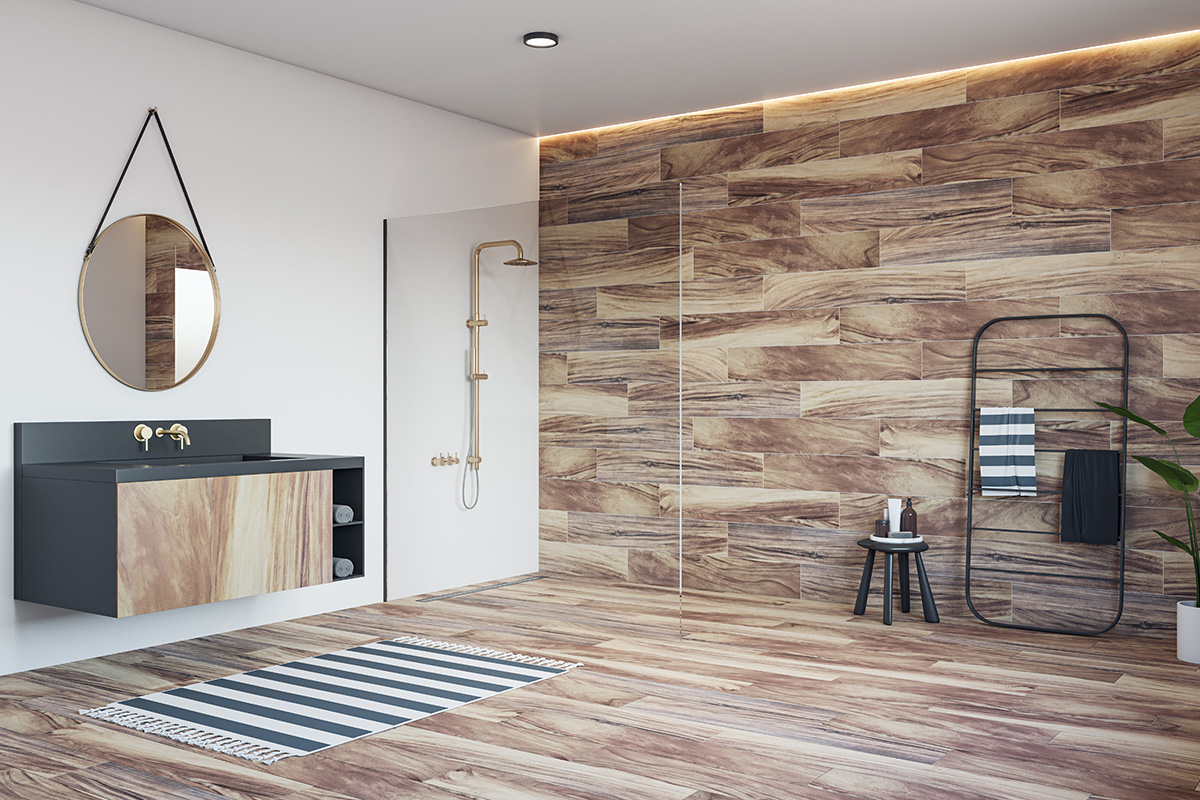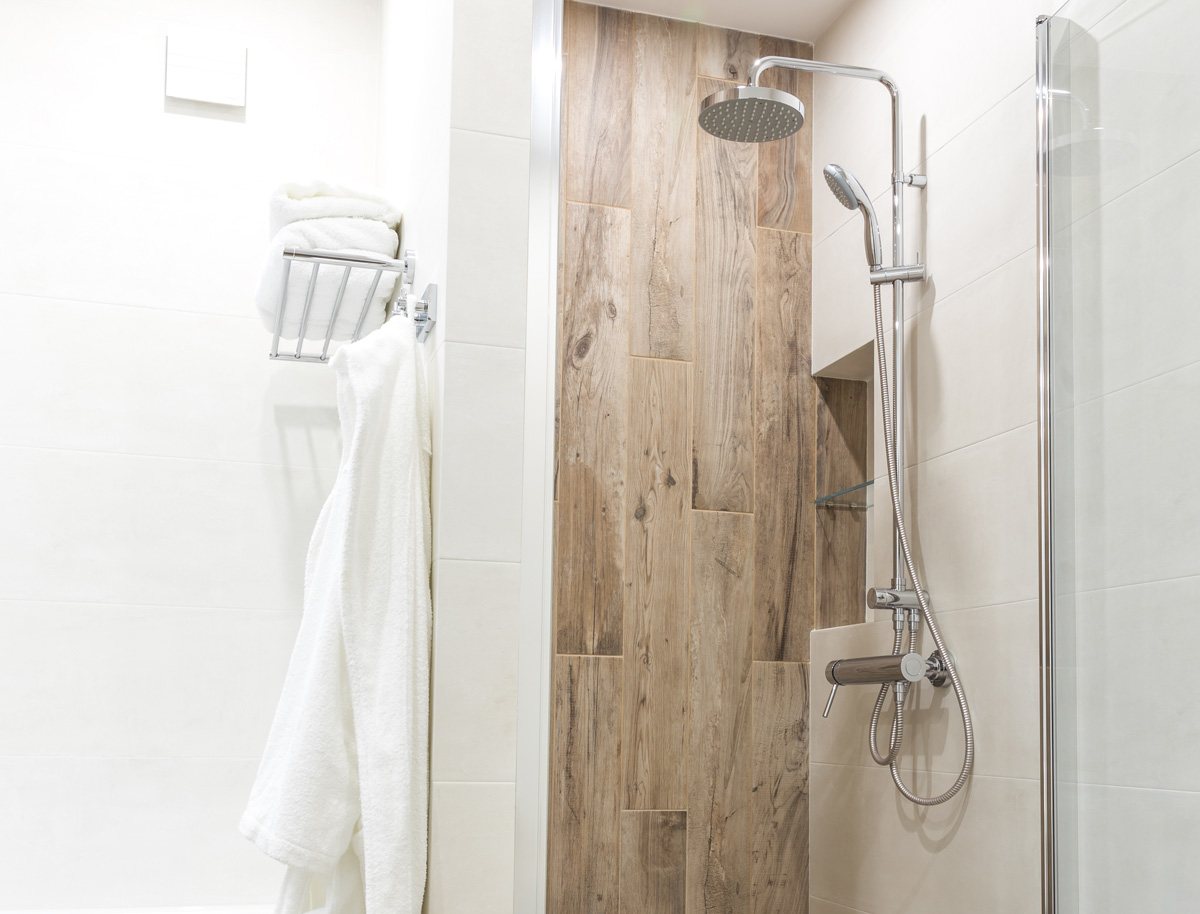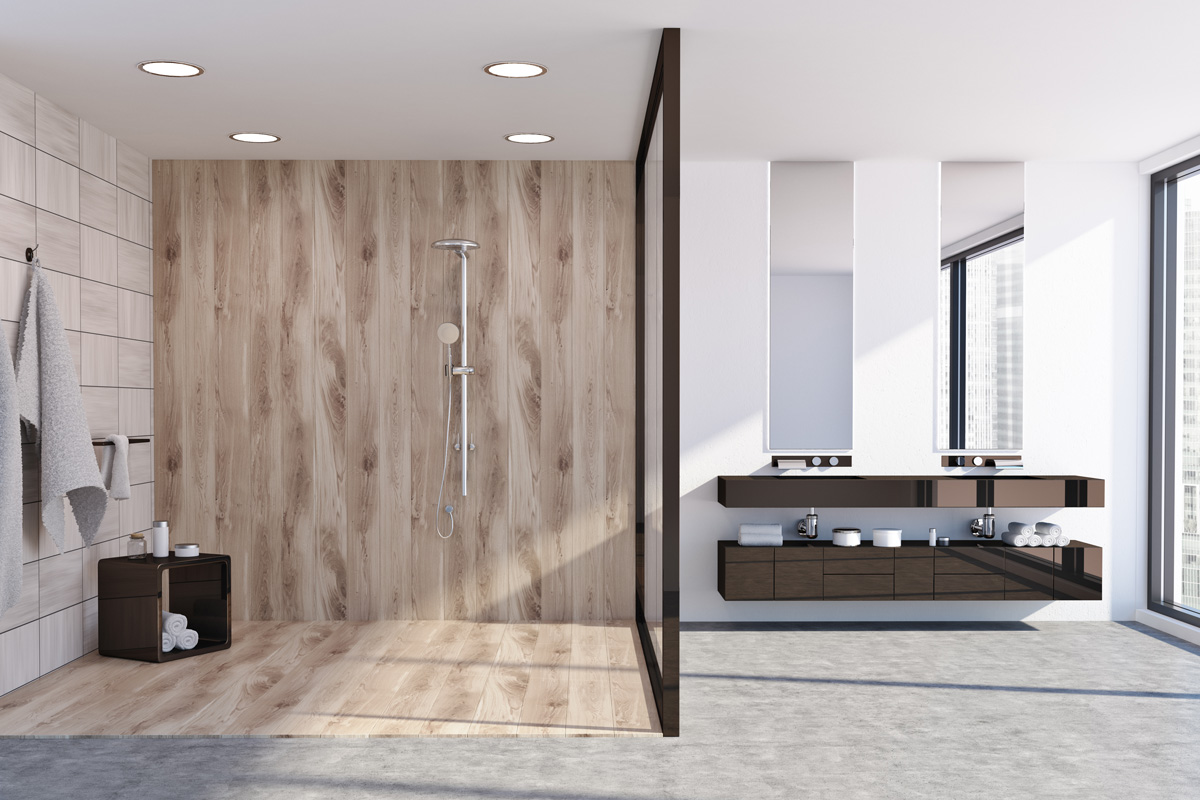Published: July 30th, 2025
Bathrooms with Wood Look Tile Floors
Wood-look tile is a solution for those who value natural materials but want to avoid the hassle of meticulous surface maintenance. It’s a cozy option for bathroom finishes and pairs well with underfloor heating to deliver 100% comfort. Artos Inc. can help design your project and select the perfect tile.
Wood-Look Flooring for the Bathroom
Wood texture is timeless. However, it’s not practical to use real wood in every room — especially in bathrooms. That’s why ceramic tile manufacturers offer collections that successfully mimic wood grain. These tiles come in both small and large formats.
Why Wood-Look Tile Is So Popular
Bathroom design projects often feature ceramic tile with wood grain patterns. It’s a beautiful finish that handles high temperatures and humidity extremely well.
Aesthetic Appeal
High-definition inkjet printing and textured surfaces allow ceramic tiles to accurately replicate the look of real wood.
Wood-look tile often features smooth edges and a matte or glossy finish that mimics natural imperfections. The effect closely resembles real material. Customers appreciate the cozy warmth of wood texture combined with ceramic practicality.
Practicality
Wood is sometimes used in bathrooms, but ceramic is far more practical. It’s resistant to moisture and temperature changes, doesn’t require regular maintenance, and prevents mold or mildew growth. Improper care or installation of wooden planks can cause them to swell, warp, or fade — problems you don’t get with ceramic.

Ceramic is extremely hard and resistant to wear, allowing it to withstand heavy foot traffic without visible damage. The ability to install underfloor heating beneath it makes it even more appealing.
Advantages of Wood-Look Tile
This solution is ideal for those who want the charm of natural wood with the practicality of ceramic. In high-moisture environments with sharp temperature changes, tile is the clear winner.
- Shape:Available in square and rectangular formats, wood-look tile effectively imitates wooden planks. The variety continues to grow — some models even replicate carved grooves and textured details.
- Color:The color palette is so broad that it’s easy to find an exact match.
- Material:Ceramic and porcelain offer excellent technical qualities. Due to their density, they absorb minimal moisture and dirt, reducing the risk of mold or mildew. The surface is scratch-resistant, withstands frequent cleaning, and won’t fade under sunlight.
- Installation Patterns:Both standard and creative layouts are possible. Popular choices for bathrooms include herringbone, chevron, and checkerboard patterns. But other, more unique patterns can also be used.
Three Common Myths About Tile — Debunked
There are many misconceptions about ceramic tile. Let’s address the most common ones:
It’s slippery and dangerous.
One major concern is that ceramic floors are slippery and unsafe.
It’s true that some types of tile become slippery when wet — but those are typically meant for walls. For flooring, manufacturers offer textured tiles with enhanced slip resistance. This is measured by the coefficient of friction (COF). Many wood-look tiles meet or exceed high safety standards such as the Americans with Disabilities Act (ADA), which requires a COF of at least 0.42.
Matte, textured, or structured tiles offer excellent grip — even in showers.
It feels too cold.
Tile does feel cooler than natural wood. However, it has excellent thermal conductivity, making it ideal for underfloor heating.
If you’re not planning to install heated floors, you can reduce the cold sensation with bathroom rugs or add towel warmers with heat. These small adjustments solve the cold-floor problem effectively.
It’s too expensive.
Premium wood-look tile does cost more than some alternatives, but it’s a solid long-term investment. Porcelain can last up to 50 years without major repairs or maintenance. Unlike real wood, it doesn’t need polishing or sealing.
When considering total cost of ownership — including moisture resistance and durability — tile is often more affordable. Prices vary widely, so there’s something for every budget.
Exploring Types and Styles of Wood-Look Tile
Ceramic includes many different types of finishes — each with its own texture, surface, color, shape, and size.
Porcelain vs. Ceramic
Porcelain is made from dense clay, pressed under high pressure, and fired at elevated temperatures. It absorbs as little as 0.5% of water, making it ideal for bathrooms and even outdoor or commercial spaces.
Ceramic is more porous but typically glazed, offering decent moisture resistance. It’s best used on walls or in lower-moisture areas to avoid damage.
In terms of design, ceramic offers more vibrant colors and detailed prints thanks to better print resolution. Porcelain tends to be more limited but excels in strength and moisture resistance.
Textures, Finishes, Sizes
Modern methods — like inkjet printing, pressing, and molding — can even replicate the tactile feel of wood. Some tiles mimic saw marks, wire brushing, or hand scraping.
Matte finishes are preferred in bathrooms due to better slip resistance. Rougher textures offer even more grip, which is also useful for outdoor use.
Tile size is an important factor too. You can choose narrow planks (6×24 inches) or larger ones (8×48 inches). Larger planks elongate the space visually when laid parallel to the longest wall.
Color Variety
Size and texture aren’t the only criteria — color matters too. Today’s collections feature shades ranging from warm honey to rich chestnut and espresso tones. Cool tones, like muted browns, are also available. Advanced technology allows manufacturers to produce not just solid colors but also nuanced gradients that mimic real wood grain.
Popular wood-look tiles mimic oak, maple, walnut, hickory, acacia, and teak. The realism is so precise that it’s often hard to tell the difference — even up close. Some collections feature aged or reclaimed wood looks, perfect for loft-style interiors.
Tile Installation Recommendations
Installing ceramic tile is complex and best left to professionals to avoid costly mistakes later.
Subfloor Prep & Waterproofing
The first step is creating a strong, waterproof subfloor to prevent cracking, shifting, or moisture intrusion. The surface must be dry, clean, and level — no more than 1/8″ variation over 10 feet (ANSI A108).
Waterproofing is essential. This can be done with liquid barriers or sheet membranes. Systems like Schluter-DITRA or RedGard are excellent for handling subfloor movement and preventing cracks. Alternatively, cement backer boards offer dimensional stability and compatibility with thin-set adhesives.
Skipping this step can lead to cracks and tile detachment. Repairs will be expensive.
Choosing & Applying Grout
Once the tile is set, grout is applied between joints — not just for aesthetics but also to seal out moisture.
Since we’re mimicking hardwood flooring, grout color matters. To create a realistic look, grout lines should be narrow — 1/16″ to 1/8″. The grout should match the tile’s tone for a seamless appearance.
Use sanded grout for wider joints (1/8″ or more), and unsanded or fine grout for smaller joints. Epoxy grout is ideal — it costs more but is waterproof, stain-resistant, and durable.
Layout Patterns
For a classic wood floor look, use staggered or brick-style layouts. Creative options like herringbone or chevron add dynamic style — even in small bathrooms.

Longer planks (36″, 48″, 60″) enhance realism and create smooth flow, especially in larger bathrooms. Mixing widths or creating accent zones can make your bathroom truly unique.
Maintaining the Beauty of Ceramic Tile
Tile is low-maintenance. Simply clean off water residue and scrub grout lines as needed. If grout becomes discolored, it can be replaced.
Why Wood-Look Tile Is a Top Trend
Natural materials bring warmth and calm, which appeal to both designers and homeowners. Ceramic is a universal material — moisture-proof, fade-resistant, and durable (especially porcelain). It handles wear and impact without scratching.
Its biggest advantage is versatility. Wood grain complements any style, and with the wide color palette available, matching is easy.
FAQ
With proper installation, it can last 50 years or more. It won’t scratch, fade, or require refinishing — just occasional grout replacement.
It’s ceramic or porcelain tile that replicates wood texture using printing and surface embossing.
No. A small grout joint is necessary to accommodate expansion and prevent moisture from seeping between tiles.
Popular choices include staggered brick and herringbone patterns. These layouts give a modern look.
It gives the appearance of wood in moisture-prone areas without the maintenance. It’s durable, color-stable, and cost-effective — when installed properly.
